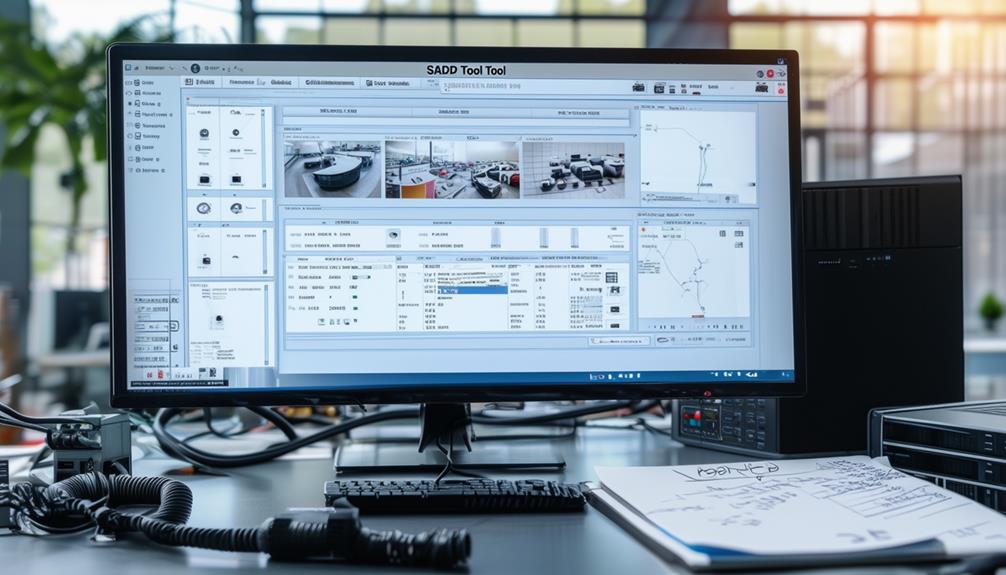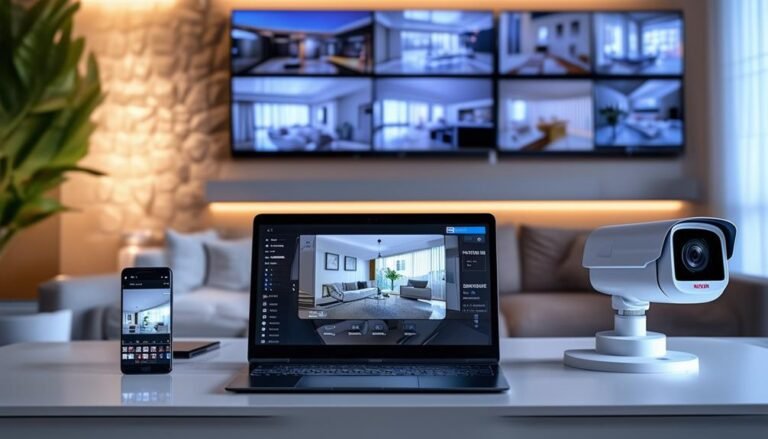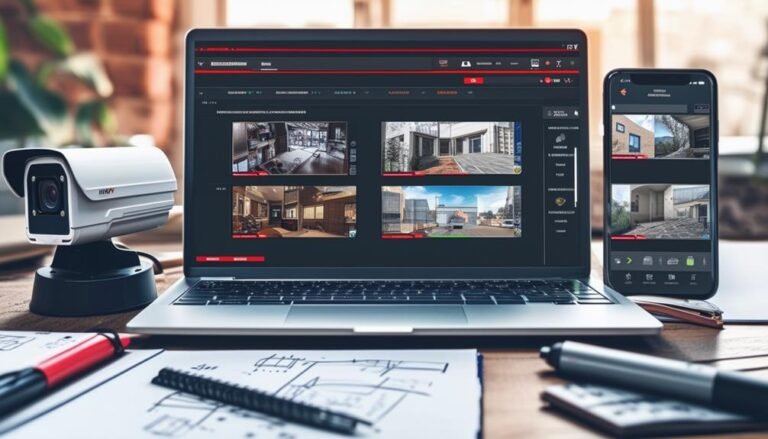To reset your Hikvision DVR password using the SADP Tool, start by downloading and installing the tool from the official Hikvision website. Make sure your DVR is powered on and connected to the same network as your computer. Launch SADP, scan for devices, and locate your DVR in the list. Select it, then choose the password reset option. Enter your associated email address to receive a verification code. Input that code, then set and confirm your new password. This process will help you regain access easily. There's more you might find helpful, so keep going to enhance your understanding!
Understanding the SADP Tool
When it comes to resetting your Hikvision DVR password, understanding the SADP (Search Active Device Protocol) tool is fundamental. This powerful utility is designed to help you manage your Hikvision devices by allowing you to locate and configure them over your network. By comprehending how SADP works, you can regain control over your DVR without unnecessary hassle.
SADP scans your local area network for Hikvision devices, making it easier for you to find the one you've been locked out of. Once you run the tool, it displays a list of all connected Hikvision devices, along with their IP addresses, device types, and firmware versions. This information is vital for understanding your network setup and pinpointing the device you need to access.
Moreover, SADP gives you the option to reset your password directly from the interface. This feature can save you time and frustration, especially if you're keen on maintaining your freedom to manage your surveillance system effectively. You won't have to navigate through complicated menus or investigate into technical manuals; SADP simplifies the process for you.
Downloading and Installing SADP
To get started with resetting your Hikvision DVR password, you'll need to download and install the SADP tool. This software is essential for accessing your device and managing its settings. Here's how you can get it set up easily:
- Visit the Hikvision website: Navigate to the official Hikvision site where you can find the latest version of the SADP tool.
- Select the appropriate version: Make certain to choose the version that matches your operating system, whether it's Windows or Mac.
- Download the installer: Click the download link and save the installer file to your computer. This might take a few moments, depending on your internet speed.
- Run the installer: Once the download is complete, locate the file and double-click it to start the installation process. Follow the on-screen prompts; it's usually just a matter of clicking "Next" a few times.
After the installation is complete, you'll have the freedom to access your DVR settings without hassle. The SADP tool will help you regain control over your device, giving you peace of mind. Remember, having the right tools at your fingertips is key to managing your security system effectively, so don't rush through this step. Take your time to verify everything is in place before moving on to the next stage of resetting your password. With SADP installed, you're one step closer to securing your freedom!
Connecting to Your DVR
Connecting to your DVR is an essential step in the password reset process. To get started, verify that your DVR is powered on and connected to the same network as your computer running the SADP tool. This connection is significant because it allows your computer to detect the DVR and facilitate communication between the two devices.
Once everything's set, launch the SADP tool. It'll scan your network for any Hikvision devices, including your DVR. In a few moments, you should see your DVR's IP address appear on the screen. If it doesn't show up, double-check your connections and make sure your DVR is correctly connected to your router or switch.
If you see your device listed, click on it. You'll notice various details displayed on the interface, such as the device name, status, and the IP address. This information is important for the next steps, so keep it in mind. If your DVR is set to a static IP, you may need to adjust your computer's network settings to match the same subnet as the DVR's IP address.
Now that you're connected, you're ready to move forward. Make certain you have everything you need at hand, including your device's serial number and any necessary information to verify your identity. This connection opens the door to resetting your password, providing you the freedom to regain control over your DVR system.
Resetting the Password
After ensuring you're connected to your DVR, it's time to reset the password. This process is essential if you've forgotten your old password and want to regain control over your security system. You'll need the SADP Tool, which is your key to freedom in managing your DVR settings.
First, launch the SADP Tool on your computer. You'll see a list of connected devices. Locate your DVR in the list, and you'll find an option to reset the password. Click on it, and follow these steps:
- Enter the email address associated with your DVR for password recovery.
- Receive a verification code sent to your email, ensuring you have access to your account.
- Input the new password you want to set, making sure it's strong yet memorable.
- Confirm the new password, ensuring it aligns with your security preferences.
Once you've completed these steps, your password will be reset, and you can log in with your new credentials. It's not just about regaining access; it's about liberating yourself from the frustration of forgotten passwords. With the right password set, you're empowered to monitor your space and protect what matters most. Enjoy the peace of mind that comes with knowing you're in charge, and remember to secure your new password in a safe place this time!
Tips for Future Security
Securing your DVR for the future is just as important as resetting your password. You want your surveillance system to remain a fortress against unwanted access. Here are some straightforward tips to enhance your security.
| Tip | Description | Frequency |
|---|---|---|
| Change Default Settings | Always change default usernames and passwords. | Upon Installation |
| Regular Updates | Keep firmware updated to patch vulnerabilities. | Quarterly |
| Enable Two-Factor Auth | Use two-factor authentication for extra security. | Whenever Available |
| Monitor Access Logs | Regularly check logs for unauthorized access. | Monthly |
Implementing these tips can drastically improve your DVR's security. First, never stick with the default settings. Always change them right after installation—it's your first line of defense. Next, stay vigilant with firmware updates; they often contain fixes for potential security holes.
Additionally, activating two-factor authentication can greatly enhance your security, making unauthorized access much more difficult. Finally, take a look at your access logs each month. If you notice anything suspicious, you can take action before it escalates.
Frequently Asked Questions
Can I Use SADP Tool on Mac or Linux Systems?
Well, isn't it ironic? You want to use SADP on Mac or Linux, but it's designed for Windows. It's almost like wanting to ride a bike in a swimming pool—just doesn't work that way! However, don't lose hope! You can explore alternatives or run a virtual machine with Windows. Freedom in tech means finding creative solutions, so why not embrace the challenge and seek out ways to make it happen? You've got this!
What if My DVR Is Not Detected by SADP?
If your DVR isn't detected by SADP, don't worry just yet. First, check your network connection; ascertain both the DVR and your computer are on the same subnet. Restarting both devices can sometimes do the trick. If that doesn't work, try using a different network cable or port. Also, consider disabling any firewalls temporarily to see if that helps. Sometimes, a little troubleshooting goes a long way in resolving connectivity issues.
Is There a Default Password for Hikvision DVRS?
Did you know that nearly 60% of surveillance system users forget their passwords? If you're wondering about a default password for Hikvision DVRs, there isn't one universally set across all devices. Each unit typically requires you to create a unique password during setup for security reasons. If you're looking to regain access, consider using the reset options available or consult the user manual for more specific guidance tailored to your device.
How Often Should I Change My DVR Password?
You should change your DVR password regularly to keep your system secure. It's recommended to update it every three to six months, especially if you notice any suspicious activity or if you've shared it with others. Consistent password updates help protect your privacy and prevent unauthorized access. Remember, using strong, unique passwords makes it harder for intruders to gain control, so don't hesitate to make those changes frequently!
Can I Reset the Password Remotely Using SADP?
Think of your DVR password like a key to a treasure chest; you want it secure but accessible. Unfortunately, you can't reset the password remotely with SADP. It's designed for local access, so you'll need to be physically present to make changes. While it might feel restrictive, this guarantees your security remains tight. Just remember, keeping your password fresh and strong is essential for freedom from potential breaches!



